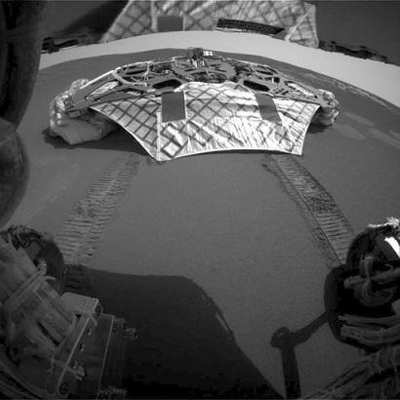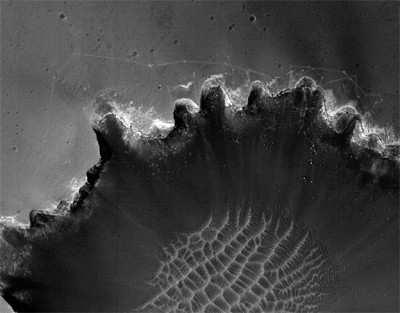Mon, Aug 15, 2011
Opportunity Escapes Crater, Travels 13 Miles To New Target
The Opportunity Mars Rover, arguably one of the best values NASA
has ever got for its money, has completed a journey of almost three
years and reached the Red Planet's Endeavour crater to study rocks
never seen before.

Tuesday, the golf cart-sized rover relayed its arrival at a
location named Spirit Point on the crater's rim. Opportunity drove
approximately 13 miles (21 kilometers) after climbing out of the
Victoria crater.
"NASA is continuing to write remarkable chapters in our nation's
story of exploration with discoveries on Mars and trips to an array
of challenging new destinations," NASA Administrator Charles Bolden
said. "Opportunity's findings and data from the upcoming Mars
Science Laboratory will play a key role in making possible future
human missions to Mars and other places where humans have not yet
been."

Endeavour crater, which is more than 25 times wider than
Victoria crater (pictured), is 14 miles (22 kilometers) in
diameter. At Endeavour, scientists expect to see much older rocks
and terrains than those examined by Opportunity during its first
seven years on Mars. Endeavour became a tantalizing destination
after NASA's Mars Reconnaissance Orbiter detected clay minerals
that may have formed in an early, warmer and wetter period.
"We're soon going to get the opportunity to sample a rock type
the rovers haven't seen yet," said Matthew Golombek, Mars
Exploration Rover science team member, at NASA's Jet Propulsion
Laboratory (JPL) in Pasadena, CA. "Clay minerals form in wet
conditions so we may learn about a potentially habitable
environment that appears to have been very different from those
responsible for the rocks comprising the plains."
The name Spirit Point informally commemorates Opportunity's twin
rover, which stopped communicating in March 2010. Spirit's mission
officially concluded in May.
NASA launched the Mars rovers Spirit and Opportunity in the
summer of 2003. Both completed their three-month prime missions in
April 2004, reaching the end of their design lives, but have
continued years of extended operations. They have made important
discoveries about wet environments on ancient Mars that may have
been favorable for supporting microbial life.
More News
He Attempted To Restart The Engine Three Times. On The Third Restart Attempt, He Noticed That Flames Were Coming Out From The Right Wing Near The Fuel Cap Analysis: The pilot repor>[...]
Make Sure You NEVER Miss A New Story From Aero-News Network Do you ever feel like you never see posts from a certain person or page on Facebook or Instagram? Here’s how you c>[...]
From 2009 (YouTube Edition): Leading Air Show Performers Give Their Best Advice for Newcomers On December 6th through December 9th, the Paris Las Vegas Hotel hosted over 1,500 air >[...]
Aero Linx: NASA ASRS ASRS captures confidential reports, analyzes the resulting aviation safety data, and disseminates vital information to the aviation community. The ASRS is an i>[...]
“For our inaugural Pylon Racing Seminar in Roswell, we were thrilled to certify 60 pilots across our six closed-course pylon race classes. Not only did this year’s PRS >[...]
 NTSB Final Report: Rutan Long-EZ
NTSB Final Report: Rutan Long-EZ ANN FAQ: Turn On Post Notifications
ANN FAQ: Turn On Post Notifications Classic Aero-TV: ICAS Perspectives - Advice for New Air Show Performers
Classic Aero-TV: ICAS Perspectives - Advice for New Air Show Performers ANN's Daily Aero-Linx (06.28.25)
ANN's Daily Aero-Linx (06.28.25) Aero-News: Quote of the Day (06.28.25)
Aero-News: Quote of the Day (06.28.25)




